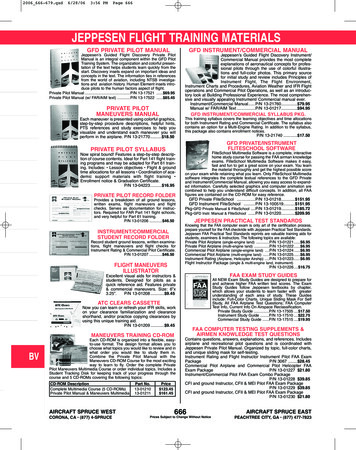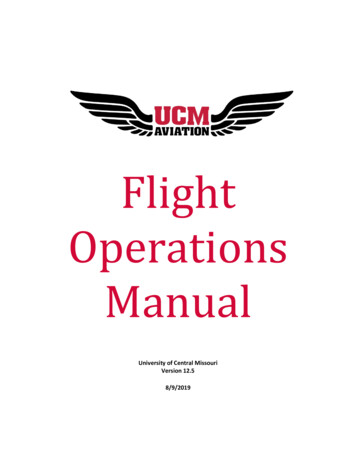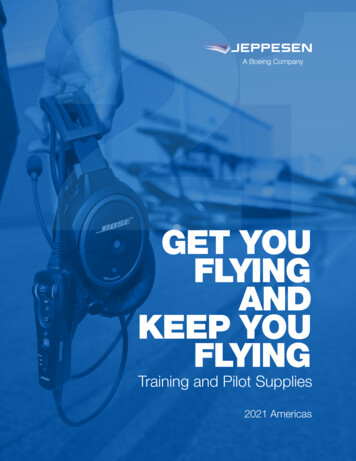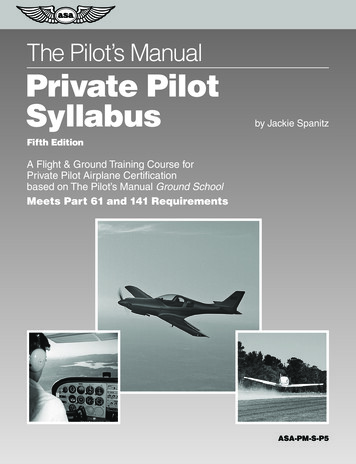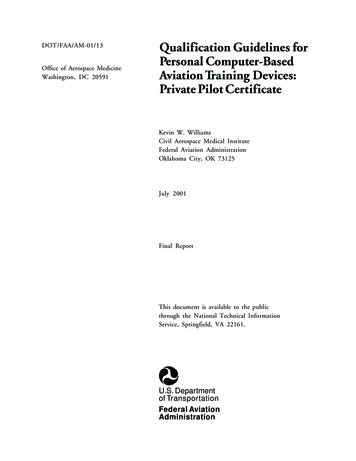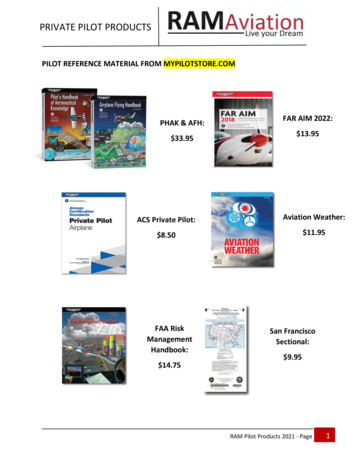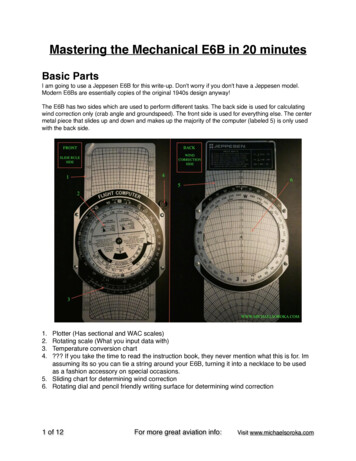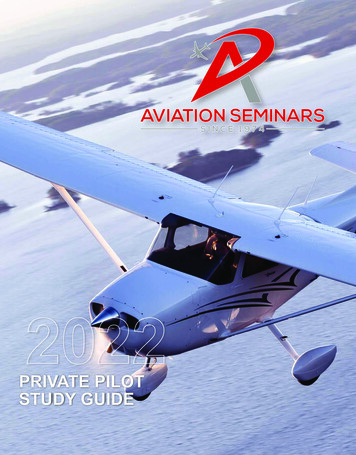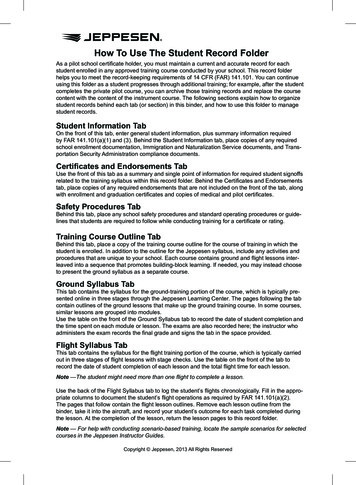
Transcription
How To Use The Student Record FolderAs a pilot school certificate holder, you must maintain a current and accurate record for eachstudent enrolled in any approved training course conducted by your school. This record folderhelps you to meet the record-keeping requirements of 14 CFR (FAR) 141.101. You can continueusing this folder as a student progresses through additional training; for example, after the studentcompletes the private pilot course, you can archive those training records and replace the coursecontent with the content of the instrument course. The following sections explain how to organizestudent records behind each tab (or section) in this binder, and how to use this folder to managestudent records.Student Information TabOn the front of this tab, enter general student information, plus summary information requiredby FAR 141.101(a)(1) and (3). Behind the Student Information tab, place copies of any requiredschool enrollment documentation, Immigration and Naturalization Service documents, and Transportation Security Administration compliance documents.Certificates and Endorsements TabUse the front of this tab as a summary and single point of information for required student signoffsrelated to the training syllabus within this record folder. Behind the Certificates and Endorsementstab, place copies of any required endorsements that are not included on the front of the tab, alongwith enrollment and graduation certificates and copies of medical and pilot certificates.Safety Procedures TabBehind this tab, place any school safety procedures and standard operating procedures or guidelines that students are required to follow while conducting training for a certificate or rating.Training Course Outline TabBehind this tab, place a copy of the training course outline for the course of training in which thestudent is enrolled. In addition to the outline for the Jeppesen syllabus, include any activities andprocedures that are unique to your school. Each course contains ground and flight lessons interleaved into a sequence that promotes building-block learning. If needed, you may instead chooseto present the ground syllabus as a separate course.Ground Syllabus TabThis tab contains the syllabus for the ground-training portion of the course, which is typically presented online in three stages through the Jeppesen Learning Center. The pages following the tabcontain outlines of the ground lessons that make up the ground training course. In some courses,similar lessons are grouped into modules.Use the table on the front of the Ground Syllabus tab to record the date of student completion andthe time spent on each module or lesson. The exams are also recorded here; the instructor whoadministers the exam records the final grade and signs the tab in the space provided.Flight Syllabus TabThis tab contains the syllabus for the flight training portion of the course, which is typically carriedout in three stages of flight lessons with stage checks. Use the table on the front of the tab torecord the date of student completion of each lesson and the total flight time for each lesson.Note —The student might need more than one flight to complete a lesson.Use the back of the Flight Syllabus tab to log the student’s flights chronologically. Fill in the appropriate columns to document the student’s flight operations as required by FAR 141.101(a)(2).The pages that follow contain the flight lesson outlines. Remove each lesson outline from thebinder, take it into the aircraft, and record your student’s outcome for each task completed duringthe lesson. At the completion of the lesson, return the lesson pages to this record folder.Note — For help with conducting scenario-based training, locate the sample scenarios for selectedcourses in the Jeppesen Instructor Guides.Copyright Jeppesen, 2013 All Rights Reserved
Repeat Lesson SheetsIf the desired outcomes in a lesson are not met, use one of the yellow Repeat Lesson sheets todocument subsequent flights to complete the lesson. These sheets must be kept as part of thisrecord folder.For each lesson that requires additional flights, record the lesson number, the objective, and theunsatisfactory tasks that require additional practice. Fill in the desired outcome for each task, theactual outcome, and the completion standards that must be met for the lesson to be consideredcomplete. Upon completion of a repeat flight, file the Repeat Lesson sheet behind the original flightlesson.Course ElementsThe Jeppesen pilot course contains separate ground and flight segments. You may combine theground and flight segments of the course or divide the course into separate components. The syllabus and support materials act as a map that helps you guide your students through the coursein a logical sequence. Refer to the Time Allocation Table behind the Training Course Outline tab tolearn how the ground, flight, and other lessons are presented in a building block sequence.Ground TrainingGround school training is an integral component of the Part 141 pilot certification course. If yourschool environment permits, presenting the ground and flight lessons in the sequence shown in theTime Allocation Table is the most effective method of course delivery. This sequence helps studentsgain pertinent academic knowledge immediately before applying it during flight training. However,the combined ground and flight training might not be practical at universities, colleges, and otherpilot schools. If ground training must be conducted as a separate course, then it is best to scheduleit to begin before the first flight lesson, and stay about one stage ahead of the flight training.Students typically complete the lessons in numerical order as listed in the Ground syllabus.However, to accommodate individual student needs, your chief instructor may approve changes tolessons as long as the course continuity is maintained and all objectives are covered.Ground LessonsThe pages behind the Ground Syllabus tab contain outlines for the ground lessons in your course.Each ground lesson outline contains the following components:Lesson Objective — A concise statement of what the student must accomplish in this lesson.Lesson References — These elements guide your students to textbook sources on whichthis lesson is based.Completion Standards — How you know that this lesson is complete.Content — The topics completed online in the Jeppesen Learning Center to complete this lesson.Each ground lesson includes the content, a practice opportunity for most lesson topics, and anexam. The lessons concisely explain the core objectives in a logical building-block sequence.Students can also explore supplemental information in pop-up windows such as Discovery boxes,Human Factors Elements, More Info, and Technical Perspectives. And throughout the lesson,students can read focused explanations of FAA knowledge test questions in FAA question pop-upwindows.Most Jeppesen pilot-training courses are based on a Jeppesen textbook, a comprehensive reference that your students can obtain either as an e-book or a bound textbook. Students can usethe Jeppesen FAR/AIM manual or e-book as a reference for studying regulations and air trafficprocedures. Refer to the Lesson References in each ground lesson outline for resources specific tothe lesson.Additional LessonsThe Jeppesen course can include additional lessons to enhance student knowledge related togaining a skill. For example, the Private Pilot course contains online maneuvers lessons thatCopyright Jeppesen, 2013 All Rights Reserved
provide step-by-step procedural descriptions of each maneuver that students are required to perform in the airplane. Normally, these additional lessons are not required by the basic Part 141 pilotcertification course. Check the Lesson Time Allocation Table to determine whether the time for theselessons is included in the required ground-training time.Stage ExamsThe ground training course includes an online lesson devoted to each stage exam. These examsevaluate student understanding of the knowledge areas within a stage, and they must be proctoredby an instructor. Even when the student takes a stage exam online, the school must arrange to havean instructor present when the stage exam is administered. Before students can progress to thenext stage, they must successfully complete each stage exam and review each incorrect responsewith their instructor.End-of-Course ExamWhen all ground lessons are complete, the student then takes the End-of-Course Exam. As with thestage exams, the End-of-Course Exam must be proctored by an instructor. Following the exam, theinstructor assigns each student appropriate subject areas for review. After thoroughly reviewing theexam, it is recommended that the student take the appropriate FAA airman knowledge test as soonas possible.Scheduling FAA Knowledge TestsPart 141 schools typically have onsite testing centers that students use for taking their FAA knowledge tests. The onsite testing centers are normally affiliated with one of the following test providers:Computer Assisted Testing Service 1-800-947-4228 or (650) 259-8550PSI/LaserGrade Computer 1-2754 or (360) 896-9111Students studying under Part 61 should schedule their knowledge test directly with these test providers.Flight TrainingThe flight training syllabus is a scenario-based approach to training pilots that emphasizes thedevelopment of critical thinking and decision-making skills. A variety of techniques enable studentsto take a more active role during training—planning flights that incorporate scenarios, making andimplementing decisions, and measuring their own performance using learner-centered grading.You can review more information about how Jeppesen implements scenario-based training at theend of this section.Most of the Jeppesen pilot training courses consist of three stages, each of which provides animportant segment of the training. Each stage builds on previous learning; therefore, they should becompleted in sequence. However, to accommodate individual student needs, your chief instructormay approve changes to lessons, as long as the course continuity is maintained and all objectivesare covered.Flight LessonsTip—Remove one of the flight lessons from the binder and use it for reference as you read this section.Flight lessons normally include the following sections and mission tables:Objectives — These are the goals, or high-level objectives, for the lesson. Prior to the flight, thestudent and instructor review the objectives and the completion standards for the lesson.Copyright Jeppesen, 2013 All Rights Reserved
Preflight Briefing — Before each flight, the student leads the preflight briefing discussion of thetasks listed in the Preflight Briefing mission table [Figure 1].TaskOutcomeIntroduce tasksq CompletedSpecial emphasis itemsq CompletedReview tasksq CompletedFigure 1. Example of a Preflight Briefing TableAn important part of a student’s ADM skills development occurs during this part of the lesson. Student ADM skill is expected to increase as the student progresses through the course.Introduce/ Review/ Evaluate — This mission table contains the core tasks of the lesson. [Figure 2]TaskOutcomePreflight PreparationIntroduceCross-Country Flight PlanningNavigationIntroducePilotage and Dead ReckoningIntroduceNavigation Systems and Radar ServicesIntroduceDiversionIntroduceLost ProceduresReviewWeather InformationReviewNational Airspace SystemReviewSoft-Field Takeoff and ClimbReviewSoft-Field Approach and LandingReviewShort-Field Takeoff & Maximum Performance ClimbReviewShort-Field Approach and LandingPreflight PreparationTakeoffs, Landings, and Go-AroundsFigure 2. Example of a Introduce, Review or Evaluate TableEach flight begins with the tasks labeled Introduce; the scenario should be based on these tasks.Tasks from previous lessons, which are labeled as Review in the table, are reviewed as needed. Ifthe lesson is a stage check, the tasks are labeled Evaluate. The student and instructor evaluate student performance using the Desired OutcomeLevel columns of the table. The student and instructor agree on an outcome level foreach task (D, E, Pr, Pe, NO)*. The student and instructor also evaluate the Aeronautical Decision Making (ADM) skillsthat are associated with individual tasks. The student ADM skill should be at the Manage/Decide level prior to completing the course.*The meaning of the outcome levels is explained later in this section.Copyright Jeppesen, 2013 All Rights Reserved
Completion Standards — These standards are statements of what must be accomplished for thelesson to be considered complete. Normally, the lesson is complete when the desired outcomes forevery task in the lesson are met.Postflight BriefingAfter each flight, the student leads the postflight briefing discussion of the tasks listed in the Postflight Briefing mission table. [Figure 3]TaskOutcomeIntroduce tasksq CompletedSpecial emphasis itemsq CompletedReview tasksq CompletedDiscuss remedial activities if minimum standards are not metq CompletedFigure 3. Example of a Postflight Briefing TableThe student and instructor evaluate student performance, discuss their respective findings, andagree on an outcome (E, P, M)*. If the student is not advancing as expected regarding ADM skills,the instructor coaches the student in areas that need improvement.*The meaning of the outcome levels is explained later in this section.Actual Time for this Lesson—Record the time here and on the back of the Flight Syllabus tab.Student Total Time to Date—Record the time here and on the back of the Flight Syllabus tab.Study Assignment—To prepare for the next flight lesson, the student must review the coursematerials that are listed in the study assignment. Reference materials typically include the groundlessons that are most closely associated with the tasks and maneuvers that are introduced in theflight lesson.Flight Simulation Device or Flight Training DeviceIf your pilot school has a flight simulation device, flight training device (FTD), or aviation trainingdevice (ATD), you might be able to use it to meet some of the required hours of training. The creditvaries, depending on the course that the student is enrolled in. If you plan to use a simulator, FTD,or ATD, be sure to include this information in your training course outline.Student Stage ChecksStage checks evaluate the student’s accomplishments during each stage of training. Conductingstage checks is the responsibility of the chief instructor. However, the chief instructor may delegateauthority for conducting stage and end-of-course checks to the assistant chief instructor or thedesignated check instructor. This procedure provides close supervision of training and can provideanother perspective on a student’s progress. The stage check also enables the chief instructor toevaluate the effectiveness of the instructors.To ensure that a student has mastered the skills needed to progress to the next building block oftraining, the student must successfully complete the stage check before moving on to the nextstage.Pilot BriefingsThe syllabus might include pilot briefings, depending on the special needs of that course. Refer tothe flight syllabus or time allocation table.Pilot briefing material is located in the instructor guide for a course. Each briefing consists of a seriesof questions on the subject associated with the briefing. Answers, when appropriate, are included.Students are given the questions (not the answers) before the briefing so that they can research thematerial and gain the most benefit from the briefing.Copyright Jeppesen, 2013 All Rights Reserved
Instructors conduct the briefings as private tutoring sessions in a comfortable classroom or officeand provide ample time to discuss every question to ensure that the student understands the keypoints. Ideally, instructors conduct the briefings during the preflight orientation for the associatedflight.Part 61 TrainingThe syllabus is designed to meet all the requirements of 14 CFR Part 141 for the course in whichthe student is enrolled. The syllabus also can be adapted to meet the aeronautical knowledge,proficiency, and aeronautical experience requirements of 14 CFR Part 61. When using the syllabusfor Part 61 training, you must ensure that the total flight and ground training requirements for thatcertificate, as well as the aeronautical experience requirements, are met under Part 61.Credit for Previous TrainingAccording to 14 CFR 141.77, when a student transfers from one FAA-approved school to anotherapproved school, hours of training obtained in the previous school’s approved course may beapplied to satisfy up to 50 percent of the curriculum requirements of the receiving school. Thereceiving school determines the amount of credit to be allowed based on a proficiency test, knowledge test, or both. A student who transfers from a non-Part 141 flight school may receive creditfor up to 25 percent of the curriculum requirements for knowledge and experience, and must alsobe tested by the receiving school. In addition, the previous provider of the training must certify theamount and kind of training given, including the result of each stage check and end-of-course test, ifapplicable. Place copies of these records (if applicable) behind the Student Information tab.Copyright Jeppesen, 2013 All Rights Reserved
How to Evaluate Student PerformanceUsing the Desired Outcome LevelsTip—Remove one of the flight lessons from the binder and use it for reference as you read thissection.This pilot course incorporates the latest FAA recommendations and industry practices related tolearner-centered grading and scenario-based training. (You can read more about how Jeppesenimplements these concepts later in this section). Your students are graded using desired outcomelevels. You use two grading scales for two types of desired outcome levels:Aeronautical Decision Making (ADM) — For evaluating the student’s ability to make sensibledecisions, manage risk, learn from their mistakes, and effectively self-evaluate their performanceduring the lesson.Maneuvers and Procedures — For evaluating technical competency and academic knowledge oftasks.Each flight lesson includes tables where instructors record student outcomes and compare themto desired outcomes. These tables serve as checklists to ensure that the student has met thecompletion standards for a lesson. The following tables explain the grading scales for the twotypes of desired outcome levels.Use the ADM desired outcomes levels [Figure 4] to complete the Preflight Briefing, Introduce andReview, Aeronautical Decision Making, and Postflight Briefing tables of the flight lessons. Also,circle these grades in the ADM columns of Introduce/Review tables to indicate how well the student made effective decisions and managed risk during the performance of the task.Desired Outcome Levels — Aeronautical Decision Making (ADM)Outcome LevelRequirements and ConsiderationsExplain (E)The student correctly identifies the mission and scenario risks, butrequires instructor assistance to apply concepts for managing risk andmaking effective decisions.The instructor prompts the student to identify risks and make effectivedecisions.Practice (P)The student uses risk management, SRM, and the ADM process tomake and implement effective decisions regarding the mission andscenario tasks with minimal instructor assistance.The instructor provides coaching to assist the student in correctinginstructor-identified errors.Manage/Decide (M)The student uses risk management, SRM, and the ADM process toidentify possible courses of action, and then make and implementeffective decisions regarding the mission and scenario tasks withoutinstructor assistance.The instructor does not need to provide assistance to ensure safecompletion of the flight.Before conducting solo flight, the student must meet the Manage/Decide desired outcome level for the tasks to be accomplished duringthe solo lesson.Figure 4. ADM desired outcome levelsCopyright Jeppesen, 2013 All Rights Reserved
Use the Maneuvers and Procedures desired outcomes [Figure 5] to complete the Introduce/Reviewtable (other than the ADM columns) in each flight lesson.Desired Outcome Levels — Maneuvers and ProceduresOutcome LevelRequirements and ConsiderationsComparable to the Rote level of learningThe student demonstrates understanding of the physical characteristicsand cognitive elements of the mission and scenario tasks.Describe (D)The instructor provides significant assistance to ensure the successfulcompletion of the task.Although it is not used as a desired outcome for the mission and scenariotasks, a column is provided in the Mission tables for recording this outcomelevel if the student does not achieve the Explain level.Explain (E)Comparable to the Understanding level of learning.The student demonstrates understanding of the underlying concepts andprinciples of the mission and scenario tasks and the correct methods toperform these tasks.The instructor provides assistance to successfully complete the task.This desired outcome is used when the task is introduced.Comparable to the Application level of learning.The student successfully plans and completes the mission and scenariotasks with minimal guidance from the instructor.Practice (Pr)The instructor provides coaching to assist the student in correctinginstructor-identified errors.This desired outcome is used when a task is reviewed in a lesson thatoccurs after the task was introduced. Task standards change to meet thePractice outcome based on the completion standards for the lesson.Perform (Pe)Comparable to the Correlation level of learningThe student demonstrates proficiency in performing the mission andscenario tasks without instructor assistance. At no time is the successfulcompletion of the task in doubt.The student identifies and corrects errors without instructor assistance.This desired outcome is used to signify that the student completes themission and scenario tasks to the standards outlined in the current PrivatePilot Practical Test Standards (PTS).Not Observed(NO)The task was not attempted or required during the lesson.Figure 5. Maneuvers and procedures desired outcome levelsCopyright Jeppesen, 2013 All Rights Reserved
Elements of SRMThe practical test standards explicitly require students to demonstrate effective single-pilot resourcemanagement (SRM), which is an adaptation of crew resource management (CRM) principles to thesingle-pilot cockpit. Although the SRM skills as listed in the PTS overlap each other significantly,the concepts encompassed by SRM can generally be classified into six skills as follows:1.Aeronautical Decision Making (ADM)A.Decision making process (2 models)(i)(ii)2.DECIDE model(a)Detect the problem.(b)Estimate the need to react.(c)Choose a course of action.(d)Identify solutions.(e)Do the necessary actions.(f)Evaluate the effect of the in-command responsibilityC.Hazardous attitudesD.Stress managementRisk Management (RM)Risk elements (2 classifications)A.PAVE(i)(ii)Pilot(a)I’M SAFE(b)Personal minimumsAircraft(iii) Environment(iv) External pressuresB.5Ps(i)Plan(ii)Plane(iii) Pilot(a)I’M SAFE(b)Personal minimums(iv) Passengers(v)ProgrammingCopyright Jeppesen, 2013 All Rights Reserved
3.Task Management (TM)A.Planning and prioritizationB.Timing of completion of tasksC.Resource use(i)(ii)4.Internal(a)Checklists(b)Flow patternsExternalSituational Awareness (SA)A.Regular evaluation of the 5Ps.B.Use of standard operating procedures (SOPs)C.Workload managementD.(i)Managing distractions(ii)Avoiding fixationCommunications(i)Sterile cockpit(ii)Crew coordination(iii) Radio procedures5.6.Controlled Flight Into Terrain (CFIT) AwarenessA.Flight planning using current chartsB.Analysis of terrain and obstacle hazards along intended routeC.Understanding and interpreting terrain displaysD.Planning of departures to avoid terrainE.Adjusting route to avoid terrainF.Consideration of terrain during diversionsG.Aircraft performance limitations and CFIT riskAutomation ManagementA.Skillful operation of autopilot and FMS under normal conditionsB.Recognition of operating modes and mode changesC.Anticipation of next operating modeD.Recognition and correction of unanticipated mode changesE.Automation Levels. Reduction of automation use, including “hand-flying.”F.(i)After an unexpected mode change(ii)After a change in flight plan or clearanceMaintaining “hand-flying” skillsThe considerations that are listed in the SRM element of each flight lesson are normally classifiedinto the six SRM areas according to these guidelines.Copyright Jeppesen, 2013 All Rights Reserved
Implementing Scenario-Based TrainingFlight lessons have evolved from task-based training (which focused on separate maneuvers andprocedures) to scenario-based training, which recognizes that each flight is a combination of manytasks and decisions. The scenario-based curriculum incorporates concepts such as risk management, single-pilot resource management (SRM), and the Aeronautical Decision Making (ADM)process into every lesson.Professional flight instructors skillfully incorporated scenarios into their training long before the FAAformalized the concept. However, because the FAA practical test standards now specifically evaluate SRM and ADM, Jeppesen pilot courses include specific guidance for teaching these mentalskills.Tasks designated for each flight lesson are scripted into scenarios that enable students to: Relate learning individual training maneuvers to arriving at a destination safely. Practice risk assessment, SRM, and ADM process during each flight lesson. Understand that problems can have multiple solutions. Make and implement decisions and observe the impact of their actions. Consider “what if” problems that provide opportunities to make decisions in a widevariety of flight situations. Measure success by their ability to make and implement effective decisions. Recognize that effective decisions sometimes require them to pursue a different plan oroverturn a previous decision. Recognize and interrupt a chain of missed opportunities and increasing risk. Understand that their options narrow as the flight progresses.Although it is not always possible to design a scenario for every flight lesson that consists purely ofskills practice, a realistic scenario should be incorporated into any flight lesson for which it makessense. Many of the Jeppesen courses include sample scenarios in the online flight lessons, whichyou can use or modify to create your own scenarios.Learner-Centered GradingLearner-centered grading and scenario-based training together are a powerful combination fordeveloping effective decision-making skills. Learner-centered grading includes two parts—studentself-assessment and a detailed debriefing by the instructor.The purpose of the self-assessment is to stimulate growth in students’ thought processes andenhance their ability to plan and conduct tasks in the context of a scenario during flight lessons.After each flight, the student and instructor independently evaluate the tasks performed and thedecisions made during the flight. Then, the instructor and student compare evaluations and, ifappropriate, discuss alternate methods, solutions, and techniques that the student could haveused to produce a more favorable outcome to the lesson.Learner-centered grading provides an additional opportunity for students to practice solving problems, making decisions, and evaluating the quality of those decisions.Copyright Jeppesen, 2013 All Rights Reserved
Copyright Jeppesen, 2013 All Rights Reserved
Commercial Pilot Online Syllabus
Jeppesen is a registered trademark of Jeppesen Sanderson, Inc. All othertrademarks,registered trademarks, product names, and company names or logosmentioned herein are the property of their respective owners.All rights reserved. No part of this publication may be reproduced, stored in a retrieval system,or transmitted in any form or by any means, electronic, mechanical, photocopying, recording,or otherwise, without the prior permission of the publisher.10164915-001Jeppesen55 Inverness Drive EastEnglewood, CO 80112-5498Web site: www.jeppesen.comEmail: Captain@jeppesen.comCopyright JeppesenAll Rights Reserved.Published 2013
Commercial Pilot OnlineRecord of Major ChangesDateDescriptionDecember 2011OriginalAugust 2013Updated ground and flight lessons to harmonize with Jeppesen FliteTraining guides andto reflect changes to the Jeppesen onlinecommercial course. Edited introductory content for clarity.Copyright Jeppesen, 2013 All Rights Reserved
Commercial Pilot OnlinePrefaceThis syllabus meets the requirements of 14 CFR Part 141, Appendix D for preparing yourstudents for a Commercial Pilot certificate. You can also use it to prepare a commercial pilotapplicant under 14 CFR Part 61, Subpart F, if you ensure that all the Part 61 minimum timerequirements are met.The syllabus is an abstract, or digest, of the course of training. Instructors must also refer to thepertinent sections of the regulations and practical test standards when conducting the course.Doing so ensures that all aeronautical knowledge areas, flight proficiency, and experience requirements have been included during flight training and are documented in appropriate records.The terminology for maneuvers and procedures listed in the syllabus is aligned with the tasksthat are published in the FAA Commercial Pilot Practical Test Standards.The syllabus has separate ground- and flight-training courses, which should be taught concurrently if possible. The ground training syllabus is divided into three stages and contains a total of18 single-engine ground lessons with an op
to present the ground syllabus as a separate course. Ground Syllabus Tab This tab contains the syllabus for the ground-training portion of the course, which is typically pre-sented online in three stages through the Jeppesen Learning Center. The pages following the tab contain outlines of the ground lessons that make up the ground training course.


